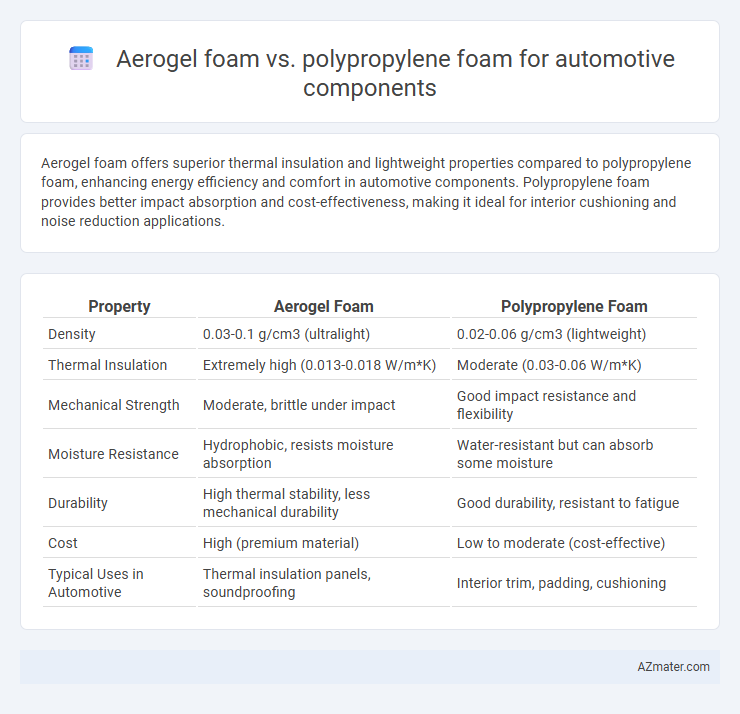Aerogel foam offers superior thermal insulation and lightweight properties compared to polypropylene foam, enhancing energy efficiency and comfort in automotive components. Polypropylene foam provides better impact absorption and cost-effectiveness, making it ideal for interior cushioning and noise reduction applications.
Table of Comparison
| Property | Aerogel Foam | Polypropylene Foam |
|---|---|---|
| Density | 0.03-0.1 g/cm3 (ultralight) | 0.02-0.06 g/cm3 (lightweight) |
| Thermal Insulation | Extremely high (0.013-0.018 W/m*K) | Moderate (0.03-0.06 W/m*K) |
| Mechanical Strength | Moderate, brittle under impact | Good impact resistance and flexibility |
| Moisture Resistance | Hydrophobic, resists moisture absorption | Water-resistant but can absorb some moisture |
| Durability | High thermal stability, less mechanical durability | Good durability, resistant to fatigue |
| Cost | High (premium material) | Low to moderate (cost-effective) |
| Typical Uses in Automotive | Thermal insulation panels, soundproofing | Interior trim, padding, cushioning |
Introduction to Automotive Foams
Automotive foams like aerogel foam and polypropylene foam serve critical roles in insulation, thermal management, and impact absorption within vehicle components. Aerogel foam, known for its ultralight weight and exceptional thermal insulation, enhances energy efficiency and noise reduction in car cabins. Polypropylene foam offers superior durability, chemical resistance, and cost-effectiveness, making it ideal for cushioning and vibration damping in automotive interiors and structural parts.
Overview of Aerogel Foam
Aerogel foam is a highly porous, ultra-lightweight material known for its exceptional thermal insulation and acoustic damping properties, making it ideal for automotive components that require efficient heat management and noise reduction. Unlike polypropylene foam, aerogel foam exhibits superior fire resistance, low density, and excellent mechanical stability under high temperature conditions. Its nanoporous structure allows for enhanced energy absorption and durability, improving vehicle safety and performance in demanding environments.
Overview of Polypropylene Foam
Polypropylene foam is a lightweight, durable material widely used in automotive components for its excellent impact absorption and thermal insulation properties. Its closed-cell structure provides superior resistance to moisture, chemicals, and fatigue, enhancing vehicle safety and longevity. Compared to aerogel foam, polypropylene foam offers cost-effective manufacturing and easy moldability, making it ideal for mass production in automotive applications.
Thermal Insulation Properties Comparison
Aerogel foam exhibits superior thermal insulation properties compared to polypropylene foam, with a thermal conductivity as low as 0.013 W/m*K, significantly reducing heat transfer in automotive components. Polypropylene foam typically has a higher thermal conductivity around 0.035-0.040 W/m*K, making it less effective at insulating against extreme temperatures. The enhanced insulating efficiency of aerogel foam contributes to improved energy savings and temperature regulation within vehicle cabins.
Weight and Density Differences
Aerogel foam exhibits ultra-low density, typically around 0.003 to 0.1 g/cm3, making it significantly lighter than polypropylene foam, which has a density ranging from 0.03 to 0.09 g/cm3. The superior lightweight nature of aerogel foam contributes to enhanced fuel efficiency and reduced vehicle mass, while polypropylene foam offers a balance of weight and structural flexibility suitable for impact-absorbing components. In automotive applications where minimizing weight is critical, aerogel foam delivers exceptional thermal insulation and weight savings, whereas polypropylene foam remains advantageous for durability and cost-effective lightweight solutions.
Mechanical Strength and Durability
Aerogel foam exhibits superior mechanical strength with high compressive resistance and exceptional impact absorption, making it ideal for automotive components requiring lightweight yet robust materials. Polypropylene foam offers good durability with resistance to chemical and environmental degradation, maintaining structural integrity under prolonged stress and temperature variations. Aerogel's brittleness limits its durability compared to polypropylene, which provides better flexibility and fatigue resistance in dynamic automotive applications.
Acoustic Performance in Automobiles
Aerogel foam exhibits superior acoustic performance in automotive components compared to polypropylene foam due to its ultra-low density and high porosity, which effectively attenuates sound waves and reduces noise transmission. Its microscopic silica structure provides enhanced thermal insulation alongside sound absorption, making it ideal for minimizing engine and road noise inside vehicle cabins. Polypropylene foam, while lightweight and cost-effective, offers lower sound dampening capabilities and higher noise transmission, limiting its effectiveness in advanced automotive acoustic applications.
Cost and Manufacturing Considerations
Aerogel foam offers superior thermal insulation and lightweight properties for automotive components but comes with higher raw material and processing costs compared to polypropylene foam, which is more cost-effective and widely available. Manufacturing aerogel foam involves complex drying processes like supercritical drying, increasing production time and expenses, while polypropylene foam benefits from established, scalable extrusion and molding techniques that reduce manufacturing costs. Choosing between these foams requires balancing aerogel's high-performance insulation and lightweight benefits against polypropylene's affordability and ease of mass production in automotive applications.
Environmental Impact and Sustainability
Aerogel foam demonstrates superior thermal insulation and lightweight properties while offering excellent biodegradability compared to polypropylene foam, which is derived from non-renewable petroleum resources and presents recycling challenges. Aerogel's lower carbon footprint and potential for green production methods enhance sustainability in automotive applications. Polypropylene foam, although durable and cost-effective, contributes to microplastic pollution and longer landfill persistence, making aerogel a more environmentally responsible choice.
Application Suitability in Automotive Components
Aerogel foam offers superior thermal insulation and lightweight properties, making it ideal for automotive components requiring high temperature resistance and energy efficiency, such as battery insulation and under-hood applications. Polypropylene foam excels in impact absorption, sound dampening, and cost-effectiveness, suited for interior parts like door panels, headliners, and seating cushions. Selection depends on specific automotive requirements, balancing thermal performance with mechanical durability and budget constraints.

Infographic: Aerogel foam vs Polypropylene foam for Automotive component
 azmater.com
azmater.com